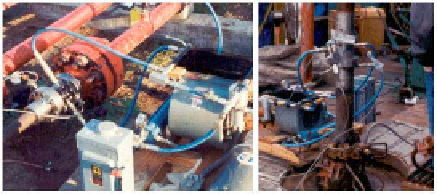Geology Reference
In-Depth Information
9.4.2
Evaluating new telemetry concepts.
In existing tools, the turbine is located beneath the pulser because it is
(incorrectly) believed that it would otherwise block the MWD signal from
traveling uphole. That little or no reflection at the turbine occurs is easily
verified in the long wind tunnel and should be apparent from its large “see
through” area. This opens up numerous possibilities for telemetry design.
Earlier we discussed the use of constructive wave interference for signal
enhancement without incurring the usual erosion and power penalties. A siren
placed nearer to the drillbit would also allow faster wave reinforcement and, by
implication, higher data rate. As we have seen in Chapter 2, the drilling
telemetry channel should support frequencies much higher than the 12 - 24 Hz
range currently used; in Chapter 10, we cite independent confirmation that much
higher frequencies can be transmitted in the drilling channel. A higher
frequency, aside from increased data rate, would be beneficial because MWD
signals can be more easily distinguished from slower acting mudpump noise.
Standard frequency filtering can be used for preliminary signal processing.
9.5 Water and Mud Flow Loop Testing
The use of a ruggedized steel test fixture for the wind tunnel system in
Figure 9.12a should be noted. This was designed so that tests performed in wind
can be effortlessly repeated in mud loop and field tests, for instance, as shown in
Figure 9.17. The siren control and signal processing station in Figure 9.13 was
developed with the same philosophy in mind. Signal processing algorithms and
telemetry tests planned and programmed in software for the wind tunnel are
transferred to the field with minimal modification. Since actual test times are
small compared to “down times” typically encountered in setting up equipment,
our approach makes optimal use of expensive test resources and labor. From
this author's experience with wind tunnel and mud loop testing, wind tunnel
problems can be diagnosed and solved much more quickly than those arising in
the field, because plumbing issues like leaks, blown hydraulic lines, opening and
closing flanges, and simply “getting wet” do not arise.
Figure 9.17.
Wind test fixture used in mud and field tests (Gardner, 2002).

Search WWH ::

Custom Search